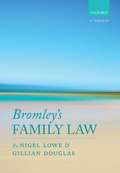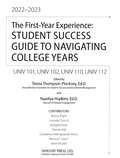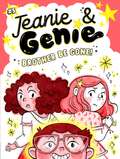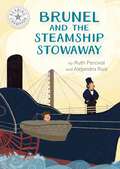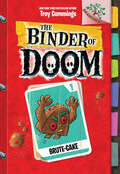- Table View
- List View
Bromley's Family Law
by N V Lowe G DouglasRelied on by generations of students and practitioners alike, Bromley's Family Law remains the definitive guide to the subject. Updated by experts in the area, Nigel Lowe and Gillian Douglas provide an accurate, detailed yet highly readable account of family law. The text presents a broad and comprehensive treatment of the key issues relating to adult and child law in a clear and distilled manner. Regular headings break up the text and allow easy navigation and quick reference for both students new to the subject and those in practice. The new edition has been fully edited and updated to take account of the latest case law and legislation, while also reflecting new debates and emerging issues in the area. Particular attention is also paid to the increasingly significant international dimension of family law, with a new chapter on this area added to the 11th edition.
Brother Be Gone! (Jeanie & Genie #5)
by Trish GrantedIn the fifth book of the Jeanie & Genie series, Jeanie just wishes her annoying little brother would disappear—but she didn&’t mean actually disappear…uh-oh.Jeanie&’s little brother, Jake, is annoying. Well, according to Jeanie he is. And sometimes Jeanie wishes he would just leave her alone! But when you have a best friend who&’s a genie, you need to be careful what you wish for. When Willow accidentally grants the wish, Jake really does disappear! Will the girls be able to figure out where Jake has gone—and how to get him back? With easy-to-read language and illustrations on almost every page, the Jeanie & Genie chapter books are perfect for emerging readers.
Brrr! (Fountas & Pinnell Classroom, Guided Reading Grade 1)
by Nick Price Rosie BensenNIMAC-sourced textbook
Brunel and the Steamship Stowaway: Independent Reading White 10 (Reading Champion #1718)
by Ruth PercivalThis story is part of Reading Champion, a series carefully linked to book bands to encourage independent reading skills, developed with Dr Sue Bodman and Glen Franklin of UCL Institute of Education (IOE) Fantastic, original stories are accompanied by engaging artwork and a reading activity. Each book has been carefully graded so that it can be matched to a child's reading ability, encouraging reading for pleasure. Perfect for 5-7 year olds or those reading book band white.
Brunnstrom's Clinical Kinesiology (Sixth Edition)
by Peggy A. Houglum Dolores B. BertotiNow celebrating its 50 years in print, this text has held onto the foundation of its great success, while also being re-invented for today’s audience. The focus of this text remains the practical instruction of functional anatomy in order to quickly, and convincingly, guide readers to its use in professional performance. This text is filled with modern applications that will show your students the relevance of foundational material to their future careers.
Brute-Cake: A Branches Book (The Binder of Doom #1)
by Troy CummingsA brand-new, monster-filled, action-packed, early chapter book series from the bestselling author-illustrator of The Notebook of Doom!Pick a book. Grow a Reader!This series is part of Scholastic's early chapter book line, Branches, aimed at newly independent readers. With easy-to-read text, high-interest content, fast-paced plots, and illustrations on every page, these books will boost reading confidence and stamina. Branches books help readers grow!Alexander Bopp is the leader of the Super Secret Monster Patrol, a club whose members are sworn to protect the town from monsters. But there haven't been monsters to fight for months... Alexander misses his best friends -- and fellow club members -- Rip and Nikki. Then he starts finding weird old-timey objects, cake crumbs, and creepy monster cards all over town! Could the monsters be back? The Super Secret Monster Patrol will have to get back together to find out! Fans of The Notebook of Doom are going to devour this exciting new series from bestselling author-illustrator Troy Cummings!
Buck and Squeak (Fountas & Pinnell Classroom, Guided Reading)
by Zeke Shepherd Bruno RobertNIMAC-sourced textbook
Buck's 2019 Step-By-Step Medical Coding
by Elsevier Inc.Buck's Step-by-Step Medical Coding is a practical, easy-to-use resource that shows you exactly how to code using all current coding sets. Explanations of coding concepts are followed by practice exercises to reinforce understanding of the material. In addition to coverage of reimbursement, ICD-10-CM, CPT, HCPCS, and inpatient coding, an Evolve website includes 30-day access to TruCode® Encoder Essentials. No other text so thoroughly covers all coding sets in one source.
Buckle Down to the Common Core State Standards, English Language Arts, Grade 3
by Triumph LearningCorrelated to the New York and Common Core State Standards! Buckle Down has just what you need to stay in step with the Common Core State Standards-a groundbreaking change in our educational system. Our new series, Buckle Down to the Common Core, will ensure that every classroom is current, focused, and on track with the CCSS initiative! Lessons introduce key skills and use examples to walk students through the ELA concepts, step by step. You'll get both targeted review and extensive practice on open-ended questions.
Buckle Down to the Common Core State Standards, English Language Arts, Grade 4
by Triumph Learning John HamNIMAC-sourced textbook
Buckle Down to the Common Core State Standards, English Language Arts, Grade 5
by Triumph LearningCorrelated to the New York and Common Core State Standards! Buckle Down has just what you need to stay in step with the Common Core State Standards-a groundbreaking change in our educational system. Our new series, Buckle Down to the Common Core, will ensure that every classroom is current, focused, and on track with the CCSS initiative! Lessons introduce key skills and use examples to walk students through the ELA concepts, step by step. You'll get both targeted review and extensive practice on open-ended questions.
Buckle Down to the Common Core State Standards, English Language Arts, Grade 6
by Triumph LearningCorrelated to the New York and Common Core State Standards! Buckle Down has just what you need to stay in step with the Common Core State Standards-a groundbreaking change in our educational system. Our new series, Buckle Down to the Common Core, will ensure that every classroom is current, focused, and on track with the CCSS initiative! Lessons introduce key skills and use examples to walk students through the ELA concepts, step by step. You'll get both targeted review and extensive practice on open-ended questions.
Buckle Down to the Common Core State Standards, English Language Arts, Grade 8
by Triumph LearningCorrelated to the New York and Common Core State Standards! Buckle Down has just what you need to stay in step with the Common Core State Standards-a groundbreaking change in our educational system. Our new series, Buckle Down to the Common Core, will ensure that every classroom is current, focused, and on track with the CCSS initiative! Lessons introduce key skills and use examples to walk students through the ELA concepts, step by step. You'll get both targeted review and extensive practice on open-ended questions.
Buckle Down to the Common Core State Standards, Mathematics, Grade 5
by Triumph LearningCorrelated to the New York and Common Core State Standards! Buckle Down has just what you need to stay in step with the Common Core State Standards-a groundbreaking change in our educational system. The new Buckle Down to the Common Core will ensure that every classroom is current, focused, and on track with the CCSS initiative! Lessons introduce key skills and use examples to walk students through the math concepts, step by step. You'll get both targeted review and extensive practice on open-ended questions.
Bud, Not Buddy
by Christopher Paul Curtis Trish P. WattsNIMAC-sourced textbook <P><P>Bud Not Buddy is a very well writen coming of age novel about an orphin boy, Bud in Flint Michigan 1936. In the middle of the depression. This book tells the story of the depression through a young african american boy who travels to find his 'father' with the only clues his mother left him when she past. But the question is, Will he find his long lost father?
Budding Reader Book Set 1: Cat and Rat (Budding Reader #1)
by Cecilia Minden Bill Madrid Doug Oglesby Melinda Thompson Melissa FerrellReading is a neurologically complex skill. So, it isn't surprising that many children find learning to read difficult. Make learning to read more fun with award-winning Budding Reader eBooks, arguably the easiest learn-to-read book series on the market. These research-based eBooks were developed in consultation with Cecilia Minden, Ph.D., the former Director of Language and Literacy at the Harvard Graduate School of Education. They were illustrated by artist, Doug Oglesby, winner of one Emmy, five Emmy nominations, and three international awards from the Broadcast Designers Association. Budding Reader eBooks use an innovative format to ease children into reading. Using research-based best practices identified by the National Reading Panel, each of the five Budding Reader eBook sets (one for each short vowel sound) tells an original story over the course of ten books. Previewing a book dramatically improves reading comprehension, so Book 1 in each set is a wordless picture book which introduces the story through colorful illustrations. Repetition aids brain development, so the story is retold in Books 2-10 with an ever-expanding vocabulary. By repeating words and gradually adding new ones, Budding Reader eBooks help new readers (even reluctant ones) experience success from the very start.In total, the Budding Reader eBook series introduces more than 60 simple words including dozens of common sight words. Learning is reinforced with free companion writing worksheets (available at buddingreader.com) which provide a multisensory experience and enable children to practice both reading and writing. A free parent guide with tips for working with new readers is also available on the website. The first set in the series, Cat and Rat, introduces the short "a" vowel sound and is designed to be a child's very first reader. With only eleven words (and, at, can, cat, look, rat, see, stop, that, the, you) introduced over the course of ten books, Cat and Rat aims to provide even the most reluctant reader with a positive first introduction to reading. Series: *Set 1: Cat and Rat (Short a; 11 words) *Set 2: Wit and Kit (Short i; 17 words) *Set 3: Bugs (Short u; 18 words) *Set 4: Hop! (Short o; 18 words) *Set 5: Hens (Short e; 22 words) For every eBook set sold, Budding Reader donates one to a child in need. One for You. One for the World. A Better World with Every Purchase. Gold Mom's Choice Award Winner: The Mom's Choice Awards has named Cat and Rat among the very best in family-friendly media, products and services. This content is optimized for tablets.
Budding Reader Book Set 2: Wit And Kit (Budding Reader #2)
by Cecilia Minden Bill Madrid Doug Oglesby Melinda Thompson Melissa FerrellReading is a neurologically complex skill. So, it isn’t surprising that many children find learning to read difficult. Make learning to read more fun with award-winning Budding Reader eBooks, arguably the easiest learn-to-read book series on the market. These research-based eBooks were developed in consultation with Cecilia Minden, Ph.D., the former Director of Language and Literacy at the Harvard Graduate School of Education. They were illustrated by artist, Doug Oglesby, winner of one Emmy, five Emmy nominations, and three international awards from the Broadcast Designers Association. Budding Reader eBooks use an innovative format to ease children into reading. Using research-based best practices identified by the National Reading Panel, each of the five Budding Reader eBook sets (one for each short vowel sound) tells an original story over the course of ten books. Previewing a book dramatically improves reading comprehension, so Book 1 in each set is a wordless picture book which introduces the story through colorful illustrations. Repetition aids brain development, so the story is retold in Books 2-10 with an ever-expanding vocabulary. By repeating words and gradually adding new ones, Budding Reader eBooks help new readers (even reluctant ones) experience success from the very start.In total, the Budding Reader eBook series introduces more than 60 simple words including dozens of common sight words. Learning is reinforced with free companion writing worksheets (available at buddingreader.com) which provide a multisensory experience and enable children to practice both reading and writing. A free parent guide with tips for working with new readers is also available on the website. The second set in the series, Wit and Kit, introduces the short “i” vowel sound and 13 new words (bit, by, did, good, he, hit, I, it, Kit, no, quit, she, Wit). Four simple words previously introduced in the series (and, see, that, you) are reviewed.Series: •Set 1: Cat and Rat (Short a; 11 words) •Set 2: Wit and Kit (Short i; 17 words) •Set 3: Bugs (Short u; 18 words) •Set 4: Hop! (Short o; 18 words) •Set 5: Hens (Short e; 22 words) For every eBook set sold, Budding Reader donates one to a child in need. One for You. One for the World. A Better World with Every Purchase. Gold Mom’s Choice Award Winner: The Mom’s Choice Awards has named Wit and Kit among the very best in family-friendly media, products and services. This content is optimized for tablets.
Budding Reader Book Set 3: Bugs (Budding Reader #3)
by Cecilia Minden Bill Madrid Doug Oglesby Melinda Thompson Melissa FerrellReading is a neurologically complex skill. So, it isn’t surprising that many children find learning to read difficult. Make learning to read more fun with award-winning Budding Reader eBooks, arguably the easiest learn-to-read book series on the market. These research-based eBooks were developed in consultation with Cecilia Minden, Ph.D., the former Director of Language and Literacy at the Harvard Graduate School of Education. They were illustrated by artist, Doug Oglesby, winner of one Emmy, five Emmy nominations, and three international awards from the Broadcast Designers Association. Budding Reader eBooks use an innovative format to ease children into reading. Using research-based best practices identified by the National Reading Panel, each of the five Budding Reader eBook sets (one for each short vowel sound) tells an original story over the course of ten books. Previewing a book dramatically improves reading comprehension, so Book 1 in each set is a wordless picture book which introduces the story through colorful illustrations. Repetition aids brain development, so the story is retold in Books 2-10 with an ever-expanding vocabulary. By repeating words and gradually adding new ones, Budding Reader eBooks help new readers (even reluctant ones) experience success from the very start.In total, the Budding Reader eBook series introduces more than 60 simple words including dozens of common sight words. Learning is reinforced with free companion writing worksheets (available at buddingreader.com) which provide a multisensory experience and enable children to practice both reading and writing. A free parent guide with tips for working with new readers is also available on the website. The third Budding Reader eBook set, Bugs, features the short “u” vowel sound. It introduces 14 new words (big, bug, bugs, down, give, go, her, hug, hugs, on, out, past, them, to) and reviews four simple words previously introduced in the series (and, by, see, the).Series: •Set 1: Cat and Rat (Short a; 11 words) •Set 2: Wit and Kit (Short i; 17 words) •Set 3: Bugs (Short u; 18 words) •Set 4: Hop! (Short o; 18 words) •Set 5: Hens (Short e; 22 words) For every eBook set sold, Budding Reader donates one to a child in need. One for You. One for the World. A Better World with Every Purchase. Gold Mom’s Choice Award Winner: The Mom’s Choice Awards has named Bugs among the very best in family-friendly media, products and services. This content is optimized for tablets.
Budding Reader Book Set 4: Hop! (Budding Reader #4)
by Cecilia Minden Bill Madrid Doug Oglesby Melinda Thompson Melissa FerrellReading is a neurologically complex skill. So, it isn’t surprising that many children find learning to read difficult. Make learning to read more fun with award-winning Budding Reader eBooks, arguably the easiest learn-to-read book series on the market. These research-based eBooks were developed in consultation with Cecilia Minden, Ph.D., the former Director of Language and Literacy at the Harvard Graduate School of Education. They were illustrated by artist, Doug Oglesby, winner of one Emmy, five Emmy nominations, and three international awards from the Broadcast Designers Association. Budding Reader eBooks use an innovative format to ease children into reading. Using research-based best practices identified by the National Reading Panel, each of the five Budding Reader eBook sets (one for each short vowel sound) tells an original story over the course of ten books. Previewing a book dramatically improves reading comprehension, so Book 1 in each set is a wordless picture book which introduces the story through colorful illustrations. Repetition aids brain development, so the story is retold in Books 2-10 with an ever-expanding vocabulary. By repeating words and gradually adding new ones, Budding Reader eBooks help new readers (even reluctant ones) experience success from the very start.In total, the Budding Reader eBook series introduces more than 60 simple words including dozens of common sight words. Learning is reinforced with free companion writing worksheets (available at buddingreader.com) which provide a multisensory experience and enable children to practice both reading and writing. A free parent guide with tips for working with new readers is also available on the website. The fourth Budding Reader eBook set, Hop!, features the short “o” vowel sound. It introduces 11 new words (Bop, do, hop, hops, looks, Mop, Pop, not, they, up, will) and reviews seven simple words previously introduced in the series (and, at, down, go, look, on, stop).Series: •Set 1: Cat and Rat (Short a; 11 words) •Set 2: Wit and Kit (Short i; 17 words) •Set 3: Bugs (Short u; 18 words) •Set 4: Hop! (Short o; 18 words) •Set 5: Hens (Short e; 22 words) For every eBook set sold, Budding Reader donates one to a child in need. One for You. One for the World. A Better World with Every Purchase. Gold Mom’s Choice Award Winner: The Mom’s Choice Awards has named Hop! among the very best in family-friendly media, products and services. This content is optimized for tablets.

